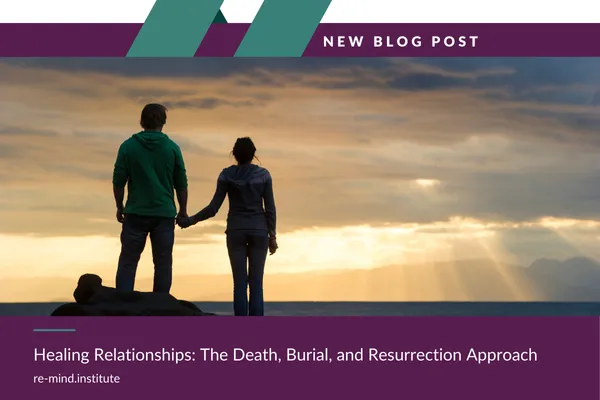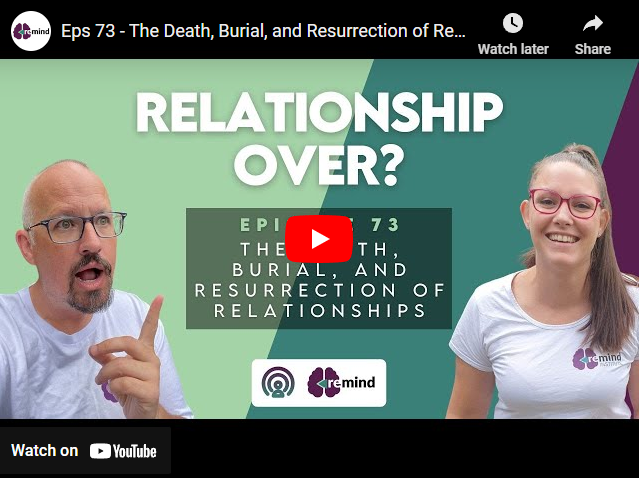
Healing Relationships: The Death, Burial, and Resurrection Approach
“Let's look at the relationship that you want to have. How do you want to feel? How do you want it to look? And then who do you both need to become in order to have that relationship.”
- Dr. Ashleigh Moreland
Welcome to the Re-MIND Institute blog. I’m Dr. Ashleigh Moreland, and today I want to explore a transformative approach to relationships that we recently discussed on the Re-MIND Podcast: the "Death, Burial, and Resurrection" process. This method addresses the deep-rooted issues of inherited shame and learned behaviours that often sabotage our connections. By recognising and resolving these patterns, we can rebuild relationships that are emotionally healthy and fulfilling.
In this post, I'll share practical tools, scenarios, and tangible coaching elements to help you apply these concepts in your own life. Whether you're struggling with relationship challenges or seeking to elevate your connection with your partner, these strategies will guide you towards healing and revitalising your relationships.
Understanding Inherited Shame and Learned Behaviours
Shame is a sneaky but pervasive emotion that can profoundly impact our relationships. It is the emotion that drives our self-centred approach to every situation - someone doesn’t respond to a text, and we make it about us? Shame. Someone is in a bad mood, and we assume it’s our fault? Shame. Kids misbehaving in public and we want them to stop so others don’t judge our parenting? Shame. It literally shows up everywhere, and it often stems from early life experiences or is passed down (learned) through generations. We inherit the language, behaviours, and thought processes of shame from our parents and environment. This first-hand OR inherited shame can manifest in various ways, such as defensiveness, withdrawal, or aggression, ultimately hindering our ability to connect authentically with others.
Practical Tool: Self-Reflection
Begin by reflecting on your own experiences with shame. Consider the following questions:
How did your parents or caregivers express shame or defensiveness?
What behaviours have you adopted that might be rooted in shame?
How do these behaviours impact your relationships today?
Journaling your thoughts can be a powerful way to uncover patterns and gain insights into how inherited shame influences your interactions.
Breaking the Cycle - Part 1: DEATH [of the dysfunction]
To heal your relationship, it's essential to recognise the dysfunctional patterns that have been co-created over time, and collectively agree that the relationship you had built on that foundation of dysfunction must die. This doesn't mean ending the relationship itself, but rather leaving behind the unhealthy dynamics that have been built on years of wounding and trauma.
Scenario: Addressing Defensiveness
Imagine your partner expresses feeling overwhelmed by their responsibilities at home. A typical defensive response might be to minimise their feelings or shift the focus to your own stress. Instead, practise responding with empathy and validation. For example:
Mum: "I'm really stressed about being home alone with the kids all day."
Dad: "I'm sorry you're feeling this way. What can I do to support you right now?"
OR
Dad: "I’m absolutely wrecked from working out in the weather all day."
Mum: "Thanks for working so hard for our family. Do you want to go take a shower and defrag before coming to help with ________?”
By acknowledging their experience without defensiveness, you create a safe space for open communication and connection. This MUST be a two way street though. Responses driven by shame, trauma or resentment tend to be some variation of “but what about ME?”, simply because the individual feels unseen, unheard, and unimportant.
Breaking the Cycle - Part 2: BURIAL [of the past]
Once you've identified and addressed dysfunctional patterns, it's crucial to let go of past resentments and hurts. Holding onto these old emotions and stories keeps us stuck and perpetuates the cycle of shame and defensiveness, preventing true healing and growth. We cannot move forward to co-create a healthier future, while we drag the mud from the past into it.
Practical Tool: Forgiveness Exercise
I want to be very clear - forgiveness does NOT mean condoning harmful behaviour, but rather releasing the emotional burden of past hurts. Try this exercise to foster forgiveness:
Find a quiet space and close your eyes.
Visualise the person who hurt you and the specific incident.
Acknowledge the pain you felt, and then imagine releasing it, like letting go of a balloon into the sky.
Repeat a forgiveness thought or statement, such as "I forgive you, and I release this pain."
Practise this regularly to gradually free yourself from the weight of past grievances. You will know when you have released it when your shoulders, chest and stomach relax, and you can feel your heart remaining open when you bring those things to mind. When we have fully let go of them, there is no longer any emotional charge.
Breaking the Cycle - Part 3: RESURRECTION [of a new, healthier relationship!]
With the old patterns buried, it's time to envision and co-create a new, healthier relationship dynamic. This involves both partners committing to growth, healing, and effective communication. There will be some therapeutic work required at an individual level to help process each persons own wounding - both from the past in the relationship, and their earlier lives, AND some coaching involved to support each individual with the skills, tools and resources to create and maintain their new healthier relationship.
Scenario: Relationship Alignment Blueprint
Developing a relationship alignment blueprint can help you and your partner clearly define your shared goals and the steps needed to achieve them. This is a session that I do with couples to lead them through consideration of:
Vision: What does your ideal relationship look like? How do you want to feel and interact with each other?
Values: What core values will guide your relationship? How will you embody these values in your daily interactions?
Boundaries: What boundaries need to be established to protect your emotional and psychological safety?
Communication: How will you communicate your needs, feelings, and expectations effectively?
By creating a detailed blueprint, you can align your efforts and work together towards a shared vision of a healthy, fulfilling relationship.
Building Emotional Intelligence: Key Skills for Healthy Relationships
Emotional intelligence (EI) is the ability to recognise, understand, and manage our own emotions, as well as the emotions of others. Developing EI is crucial for creating and maintaining healthy relationships.
Practical Tool: Emotion Regulation Techniques
Learning to regulate your emotions can prevent shame and defensiveness from hijacking your interactions. Here are some techniques to practise:
Mindfulness Meditation: Regular mindfulness meditation can increase your awareness of emotional triggers and help you respond more calmly.
Breathing Exercises: Deep breathing can activate your parasympathetic nervous system, reducing stress and promoting emotional stability.
Cognitive Reframing: Challenge negative thought patterns by reframing them in a more positive or neutral light. For example, instead of thinking, "My partner doesn't care about me," reframe it to, "My partner is stressed and may need support.
Continued Emotional Processing: Commit to ongoing self-awareness, and utilise your growing skills to communicate your needs, and process the chemicals of emotions effectively and quickly as they arise.
By incorporating these techniques into your day-to-day life, you can enhance your emotional intelligence and improve your interactions with others.
Communication: The Antidote to Shame
Effective communication is the cornerstone of a healthy relationship. It involves not only expressing your own needs and feelings but also actively listening to and validating your partner's experiences.
Scenario: Practising Active Listening
Active listening involves fully engaging with your partner's words, emotions, and non-verbal cues. Here's how to practise it:
Maintain Eye Contact: Show that you are fully present and focused on your partner.
Reflect and Validate: Repeat back what your partner has said to ensure you understand. For example, "It sounds like you're feeling overwhelmed because of the kids' needs. Is that right?"
Ask Open-Ended Questions: Encourage your partner to share more by asking questions like, "Can you tell me more about what's been stressing you out?"
Active listening can help you and your partner feel seen, heard, and understood, reducing the likelihood of shame-based responses.
Embracing Individual Healing for Relationship Growth
Ultimately, the health of a relationship depends on the individual healing journeys of each partner. Both partners must be willing to address their own wounds, develop new skills, and grow emotionally.
Practical Tool: Individual Therapy and Coaching
Engaging in individual therapy and coaching, while also working together to implement and execute new tools and skills into your relationship and lives can provide you with personalised support and guidance on your healing journey. At the Re-MIND Institute, our "Rise and Thrive" program is designed to help you uncover and resolve deep-seated emotional wounds, develop emotional intelligence, and build healthier relationship patterns as individuals AND together as a couple.
You might also like to join our Heart-Centred Healing Hub
For ongoing support and resources, I invite you to join our Heart-Centred Healing Hub on Facebook. This community is dedicated to providing a safe and supportive space for individuals committed to personal growth and healing. Share your experiences, ask questions, and connect with others on similar journeys. Together, we can create a ripple effect of healing and resilience.
Conclusion
Healing relationships is a complex yet rewarding process. By recognising and addressing inherited shame and learned behaviours, letting go of past hurts, and co-creating a new, healthier dynamic, you can transform your relationship into a source of strength and joy. Remember, it starts with individual healing and a commitment to growth. If you're ready to take the next step, consider joining our "Rise and Thrive" program and connect with our supportive community in the Heart-Centred Healing Hub. Together, we can create the relationships we truly desire.
Interested in learning more about working with us to transform your relationship? DM us on socials, or email [email protected]
With wellness in mind [and body, and spirit],
Dr Ashleigh Moreland
Watch Episode 73 of the Re-MIND Podcast here:

